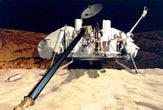Mars Life Building Blocks Possibly Seen By Viking Probes

Samples of Mars dirt collected by NASA's Viking Mars landers back in the 1970s may have contained carbon-based chemical building blocks of life as we know it, a new study suggests.
During their missions, the two Viking landers vaporized Martian dirt and scrutinized the samples for signs of organic - or carbon-based - molecules that could serve as the raw ingredients for life. At the time, all they found were chlorine compounds attributed to contamination, but the new research suggests the Viking probes' heat-treatment may have generated these chlorine compounds from naturally occurring Martian organics, destroying them in the process.
"This doesn't say anything about the question of whether or not life has existed on Mars, but it could make a big difference in how we look for evidence to answer that question," study co-author Chris McKay, of NASA's Ames Research Center in Moffett Field, Calif., said in a statement.
Organic molecules can come from non-biological or biological sources. Meteorites raining on Mars and Earth for the past 5 billion years contain organics, so even if Mars has never supported life, scientists before the Viking missions expected Martian dirt to contain at least some organics, researchers have said.
New evidence from Phoenix
The new study follows a 2008 discovery made by the Phoenix Mars Lander. In its roughly five months on Mars, Phoenix found a chlorine-containing chemical called perchlorate in the Martian dirt.
In the lab, the research team for the new study added perchlorate to some desert dirt from Chile that was known to contain organics. Then they heated the soil up, mimicking the Viking landers' organics-detection test. They found the same two organic chlorine compounds the Vikings did: chloromethane and dichloromethane.
Get the world’s most fascinating discoveries delivered straight to your inbox.
What's the connection between these three chemicals? Perchlorate becomes a strong oxidant when heated, breaking down naturally occurring organics into chloromethane and dichloromethane.
"Our results suggest that not only organics, but also perchlorate, may have been present in the soil at both Viking landing sites," the study's lead author, Rafael Navarro-González of the National Autonomous University of Mexico, said in a statement.
"[Perchlorate] could sit there in the Martian soil with organics around it for billions of years and not break them down, but when you heat the soil to check for organics, the perchlorate destroys them rapidly," McKay said.
Challenging old theories
The new study, in the current issue of the Journal of Geophysical Research – Planets, may inspire scientists to reconsider the results of the Viking mission.
The Viking landers performed several different tests on Martian surface material in 1976. They found no compelling evidence for life, or even for the existence of organic molecules.
But subsequent studies have questioned what these tests actually showed. Researchers replicating Viking's methods on Earth, for example, failed to detect signs of life in Earth soil teeming with microbes.
More than three decades ago, the two Viking landers scooped up some Martian dirt and heated it to 500 degrees Celsius (932 degrees Fahrenheit). The chlorine compounds they found were interpreted at the time as contaminants from cleaning fluids.
"The lack of organics was a big surprise from the Vikings," McKay said. "But for 30 years we were looking at a jigsaw puzzle with a piece missing. Phoenix has provided the missing piece: perchlorate. The perchlorate discovery by Phoenix was one of the most important results from Mars since Viking."
Trying to resolve the question
Upcoming Mars missions and further work on meteorites from Mars could help resolve whether Viking actually found evidence of organics on the Red Planet. Curiosity, a rover that NASA's Mars Science Laboratory mission will deliver to Mars in 2012, will range far and wide, analyzing a broad range of rocks and dirt samples. Its instruments will check for organics in Martian dirt and powdered rocks by baking samples to even higher temperatures than Viking did and by using an alternative liquid-extraction method at much lower heat.
Combining these techniques on a range of samples may help test the new study's idea that heated-up perchlorates could have destroyed organics in the Viking tests.
The European-led ExoMars mission, set to launch in 2018, will include a rover with the ability to dig about 6.5 feet (2 meters) below the Martian surface. The chances of finding complex molecules, including evidence of life such as proteins, are better underground, where molecules are protected from harsh ultraviolet radiation.
 Live Science Plus
Live Science Plus






